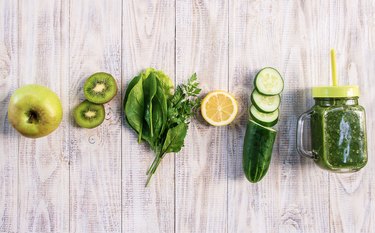
Instead of counting calories, Weight Watchers helps you gain control over your eating and lose weight using a point system. With recent updates to the plan, Weight Watchers free foods list is extensive, and it's geared toward helping you make healthier food choices.
Video of the Day
Video of the Day
Losing With Weight Watchers
Every year as many as 45 million Americans go on a diet in an attempt to lose weight, according to Boston Medical Center. Though people may choose any number of methods to help them drop weight, from the very trendy keto diet to fad diets like the seven-day Sacred Heart Diet, many follow commercial weight-loss programs to help them drop those unwanted pounds.
According to an April 2015 study published in the Annals of Internal Medicine, Weight Watchers is one of the most popular commercial programs, accounting for a large percentage of the market share when compared to other commercial diets. It's also one of the most effective. The researchers note that Weight Watchers participants consistently lose more weight and keep it off compared to people who follow their own self-directed diet plans.
Weight Watchers doesn't tell you what to eat, according to the official website. Instead, they provide you with the tools, education, motivation and support you need so you can make healthier decisions about what you eat. The program also encourages you to be more active and focuses on helping you find activities you enjoy.
How Weight Watchers Points Work
Though many diet plans claim to hold the secret to weight-loss success, they all work using the same and only premise that promotes weight loss: creating a calorie deficit. In order to drop unwanted pounds, you need to eat fewer calories than your body burns, says the American Academy of Family Physicians. Some plans help you cut calories by restricting your intake of certain macronutrients, cutting out major food groups or limiting your diet to only a few select food items.
Weight Watchers helps you create the calorie deficit you need using a points system, currently referred to as SmartPoints. According to the Weight Watchers website, calories serve as a baseline for the point value of a food. The protein content in a food lowers the point value, while its saturated fat and sugar content both raise the point value. The commercial weight-loss program cites that limiting saturated fat and sugar intake is beneficial to health, and eating more protein supports weight loss.
To help you reach your goal weight, you're given a set number of daily SmartPoints to use every day based on your sex, age, weight and height. Weight Watchers free foods, also referred to as ZeroPoint foods, don't count toward your SmartPoints.
Weight Watchers ZeroPoint Foods
Weight Watchers ZeroPoint foods are aimed at helping you make healthier food choices. These foods, according to the Weight Watchers website, were chosen because they serve as the foundation of a nutritious, balanced diet.
Weight Watchers individualizes ZeroPoint food choices, and your plan may include fruits, veggies, proteins and whole grains based on your SmartPoints balance.
Some of the items you may find on your Weight Watchers ZeroPoint foods list include:
- Broccoli, cauliflower, cucumbers, carrots, spinach
- Apples, oranges, strawberries, watermelon, pears
- Fish, shellfish, chicken breast, eggs, tofu, legumes
- Sweet potatoes, brown rice, whole-wheat pasta, oatmeal
With a large SmartPoints balance, your Weight Watchers free foods are limited to fruits and vegetables, but with a more moderate SmartPoints balance, your free foods may also include proteins and whole grains.
The Weight Watchers free foods list is based on the recommendations from the World Health Organization (WHO), according to the Weight Watchers website. The WHO specifically recommends adults eat more fruits, vegetables, whole grains, legumes and nuts.
- Boston Medical Center: "Weight Management"
- Annals of Internal Medicine: "Efficacy of Commercial Weight Loss Programs: An Updated Systematic Review"
- Weight Watchers: "About Us"
- American Academy of Family Physicians: "What It Takes to Lose Weight"
- Academy of Nutrition and Dietetics: "Staying Away From Fad Diets"
- Weight Watchers: "Everything You Need to Know About SmartPoints"
- Weight Watchers: "All About ZeroPoint Foods"
- Weight Watchers: "The Complete List of ZeroPoint Foods for myWW Purple"
- World Health Organization: "Healthy Diet"